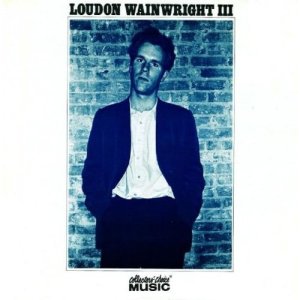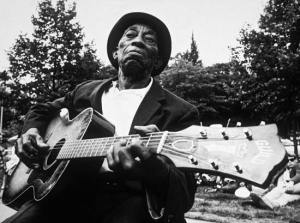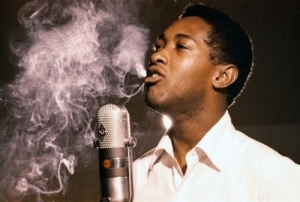In memory of the Big Man, saxophone player for the greatest band of all time, I wanted to throw a few youtube links out there to the uninitiated.
Archive for the ‘Uncategorized’ Category
Clarence Clemons (January 11, 1942 – June 18, 2011)
June 19, 2011A Note on Guitar Gods
June 5, 2011Rolling Stone Magazine’s “Greatest” lists infuriate me for countless reasons. They’re a shameless attempt to create controversy and their feigned objectivity is aggravating. I’ve always had a distaste for “Greatest Guitarist” lists of any kind, specifically those that cater to one genre of music alone (usually rock and roll). So I think there are a few things that need to be straightened out when determining criteria for being a great guitarist. I’ll pick on Rolling Stone because they have the most clout, even though countless periodicals make the same errors in judgment. Just as a disclaimer though, I am a huge fan of all the guitarists I’m discussing and the music they created.
Jimmy Page (Rolling Stone’s 9th Greatest Guitarist of All-Fucking-Time)
First off, being a great composer/songwriter/riff-writer doesn’t necessarily constitute proficiency on the instrument. Jimmy Page, as the driving force behind Led Zeppelin, has undoubtedly written and co-written some of the greatest rock songs ever pressed to vinyl. The fact that any 12-year old can play “Black Dog”, or “Stairway”, or “Over the Hills and Far Away” doesn’t mean that these tunes aren’t amazing, but it can be relevant when determining the skill-level of the composer as a guitarist.
I’ll admit, Page was probably on some kind of Jack Daniels/Heroin cocktail at the time of this performance, but it absolutely makes my case (the five minute mark is a pretty good place to start):
…a seven-year old:
Robert Johnson (Rolling Stone’s 5th Greatest Guitarist of All-Fucking-Time)
Robert Johnson recorded twenty-nine songs 75 years ago and has somehow made his way into the hearts and minds of every blues/rock guitarist since. How he became the archetypal Mississippi Delta blues man, and the subject of vaguely religious folk-lore is debatable, yet his influence on rock and blues music is undeniable. Influence, again, does not require virtuosity. Robert Johnson is an unbelievable songwriter with an amazing voice and ability to interpret classic songs and make them his own. He is a very good guitarist, but not as good as his followers make him out to be.
…blues guitar by the 5th greatest guitarist of all-time:
…or blues guitar by Joe Pass:
Johnny Ramone (Rolling Stone’s 16th Greatest Guitarist of All-Fucking-Time)
Jesus Christ, I don’t even know where to start. Love or hate punk music, to me it is impossible to call Johnny Ramone one of the greatest guitarists in history. I wholeheartedly believe if Johnny were around today he’d deny it, too. The Ramones were a necessary relief to the narcissistic rock of the late 70’s, but strumming a guitar like it insulted your mother doesn’t make you a brilliant guitarist. Kudos to inventing a music genre, though.
…and that was just the top 20. The rest of the list is a shit-show of blatantly shocking inclusions (Joan Jett) and exclusions (too many to name). I’ll steer clear of what guitarists I think could have been added or omitted to make the best list because the point of this article, if there is one, is that these lists are ludicrous. No matter the state of the record-industry, it isn’t likely that kids will stop learning to play guitar to impress the opposite sex. But perhaps it’s time to stop shoveling piles of superlatives on Jimi Hendrix and Eric Clapton just to sell magazines.
Five Terrible Pop Music Bridges by Amazing Songwriters
May 29, 2011In a traditional pop song, the bridge is that thing that isn’t the verse or the chorus. Basically, it’s an interlude section that usually contrasts lyrically and harmonically from the verse and chorus sections. A good bridge can be the keystone in the framework of a song, developing thematic elements from the lyrics and chord progression, and can be crucial to maintaining the listener’s interest. The bridges in these songs either stick out like a sore thumb, or contribute absolutely nothing to the song. I’m a huge fan of all of the songwriters I picked for this entry, but I cringe at about the halfway point in these songs.
“Veronica” Elvis Costello/Paul McCartney, 1989
“Still Crazy After All These Years” Paul Simon, 1975
“Dancing in the Dark” Bruce Springsteen, 1984
“She’s Always a Woman” Billy Joel, 1977
“Every Breath You Take” The Police, 1983
The Next Bob Dylan (Happy Birthday Bob)
May 22, 2011Zimmy turns 70 on Tuesday, and I thought rather than write a post about the man and his music, since countless music rags and blogs will be covering that, I’d write a little about the debut LPs of three singer-songwriters who emerged in the early 70s who music critics all hailed as the “next Bob Dylan”. Dylan’s messiah-like influence on every aspect of 1960s culture, and subsequent disappearing act, left a void aching to be filled by a new voice of a generation. These three artists, however, proved to be too unique to conform to the record labels’ expectations of cookie-cutter Dylan doppelgangers and have since developed their own voices and careers that remain strong well into their fifth decade in music business.
Loudon Wainwright III – Loudon Wainwright (Album I) (1970)
 Loudon Wainwright III’s first album is perhaps the most “dylanesque” of the bunch, if only in its instrumentation. A breath of fresh air for those who damned Bob for going electric, Album I has the confessional secrecy of a singer-songwriter wailing and whispering over his acoustic guitar. The album cover alone could easily have been taken after an open-mic performance in a dank, seedy New York City dive. From the opening track, “School Days”, Wainwright hooks you with his unstable, whining tenor and staggeringly original and evocative lyrics: “In the spring I had great hunger/I was Keats, I was Blake/My purple pencil pains I would bring/To frogs who sat entranced.” “School Days” shows signs of the voice that he has since developed in later songs: self-chastising, embarrassingly honest, and painfully funny. Yet songs like “Black Uncle Remus” and “Bruno’s Place” are a page out of the Dylan songbook, with undecipherable, folkloric, and biblical lyrics. Album I, although not a perfect record, is one of Wainwright’s most interesting efforts. More dark and morose than comic, Wainwright hadn’t developed his style of blending the two seamlessly yet, Album I is a beautiful 45 minutes of melancholia.
Loudon Wainwright III’s first album is perhaps the most “dylanesque” of the bunch, if only in its instrumentation. A breath of fresh air for those who damned Bob for going electric, Album I has the confessional secrecy of a singer-songwriter wailing and whispering over his acoustic guitar. The album cover alone could easily have been taken after an open-mic performance in a dank, seedy New York City dive. From the opening track, “School Days”, Wainwright hooks you with his unstable, whining tenor and staggeringly original and evocative lyrics: “In the spring I had great hunger/I was Keats, I was Blake/My purple pencil pains I would bring/To frogs who sat entranced.” “School Days” shows signs of the voice that he has since developed in later songs: self-chastising, embarrassingly honest, and painfully funny. Yet songs like “Black Uncle Remus” and “Bruno’s Place” are a page out of the Dylan songbook, with undecipherable, folkloric, and biblical lyrics. Album I, although not a perfect record, is one of Wainwright’s most interesting efforts. More dark and morose than comic, Wainwright hadn’t developed his style of blending the two seamlessly yet, Album I is a beautiful 45 minutes of melancholia.
John Prine – John Prine (1971)
John Prine is a perfect record. Although the instrumentation is more of a barroom band than a one-man show, Prine’s midwestern country twang and simple, honest lyrics take the spotlight and keep you hanging on every word. Like the best debut records, John Prine is basically a greatest hits album. “Illegal Smile,” “Sam Stone,” “Hello in There,” “Paradise,” and “Angel from Montgomery” have become country and folk standards. Prine was “discovered” by Kris Kristofferson in the Chicago folk scene where Prine had already developed his voice, writing brilliant, sad songs with a veneer of one-liners and drunken insight. Only John Prine could make a line like “There’s a hole in daddy’s arm where all the money goes” sound a little funny. John Prine is the logical conclusion of Nashville Skyline and John Wesley Harding, but the similarities are in genre alone.
Bruce Springsteen – Greetings from Asbury Park, N.J. (1973)
Bruce Springsteen is a classic example of the success one-two punch: raw talent and unbridled ambition. He treated every album like it would be his last, so his first, Greetings from Asbury Park, N.J., shows a young, eager New Jersey singer-songwriter throwing every part of his soul onto tape. It’s a cliché now, but there are more lyrics in Blinded by the Light than in entire albums. But art is about quality, not quantity, and the Boss lays it on thick. Asbury Park is the first chapter of what would become the Springsteen ethos, searching for meaning and identity under the weight of blue collar and middle-class responsibility in New Jersey beach towns like Asbury Park. Comparison’s were inevitable between Bruce and Bob. Bruce’s long-form folk compositions got him signed to Columbia, but the tracks on Asbury Park, backed by Springsteen’s cohorts in the New Jersey rock club scene, sound fully fleshed out and hint at what was to come.
Who Was Stagger Lee?
May 20, 2011It seems like every folk musician has recorded a version of Stagger Lee (or Stack A Lee, or Stagolee) at some point in their career. In my iTunes library alone I have a version by Bob Dylan, The Grateful Dead, Lloyd Price, Nick Cave & the Bad Seeds, Mississippi John Hurt, Wilson Pickett, Dr. John, and Frank Hutchison. My interest in this fella piqued again after listening to Josh Ritter’s take on the Stagger Lee story in “Folk Bloodbath”.
…anyway…
It turns out Stagger Lee, or Lee Shelton (March 16, 1865 – March 11, 1912), was a real guy. Shelton was a taxi-driver and a pimp from St. Louis, Missiouri who killed William “Billy” Lyons on Christmas Eve, 1895.
Here’s the story from the St. Louis Globe-Democrat:
William Lyons, 25, a levee hand, was shot in the abdomen yesterday evening at 10 o’clock in the saloon of Bill Curtis, at Eleventh and Morgan Streets, by Lee Sheldon, a carriage driver. Lyons and Sheldon were friends and were talking together. Both parties, it seems, had been drinking and were feeling in exuberant spirits. The discussion drifted to politics, and an argument was started, the conclusion of which was that Lyons snatched Sheldon’s hat from his head. The latter indignantly demanded its return. Lyons refused, and Sheldon withdrew his revolver and shot Lyons in the abdomen. When his victim fell to the floor Sheldon took his hat from the hand of the wounded man and coolly walked away. He was subsequently arrested and locked up at the Chestnut Street Station. Lyons was taken to the Dispensary, where his wounds were pronounced serious. Lee Sheldon is also known as ‘Stag’ Lee.
The first published versions of the lyrics appeared in the Journal of American Folklore in 1911, yet the Stagger Lee legend really began to achieve popularity with the first recordings of the song in 1923 by Fred Waring’s Pennsylvanians and Frank Westphal & His Regal Novelty Orchestra. It wasn’t until 1928, when Mississippi John Hurt recorded what is widely considered to be the classic version of the song, that Stackolee acheived it’s status as an essential part of the folk music canon.
Ten Things You Probably Didn’t Know About Sam Cooke
May 20, 2011I decided to do a little research on Sam Cooke, the groundbreaking R&B singer famous for 29 top-40 hits between 1957 and 1964 including “Cupid”, “A Change Is Gonna Come”, “You Send Me”, and “Chain Gang”. His death by shooting in 1963 was deemed a “justifiable homicide” and has since been subject to much controversy.
In (somewhat) chronological order:
- The fifth of eight children, Cooke was born the son of a preacher, Charles Cook, in Clarksdale, Mississippi. Just down the Mississippi River from Memphis, Clarksdale was the birthplace of blues legends, Muddy Waters and John Lee Hooker, and home to the famous crossroads which supposedly inspired Robert Johnson’s “Cross Road Blues”.
- Born Samuel Cook, Cooke changed his name to Sam Cooke supposedly out of superstition. He wanted a stage name with an even amount of letters.
- Cooke was a philanderer throughout his life. At age 22, he had three pregnant girlfriends.
- In 1963, Cooke’s 18 month-old son, Vincent, drowned in a pool after wandering away from Cooke’s wife’s supervision.
- Cooke, agitated, drunk, and half-naked, was shot to death by Bertha Franklin, the manager of the Hacienda Motel in Los Angeles.
- Cooke’s last words were allegedly, and understandably, “Lady, you shot me.” Then, while Cooke was still alive but bleeding from a gunshot wound to the heart, Franklin beat him with a broomstick.
- Decades after his death, there is still speculation over the truth behind the shooting. Cooke’s date on the night of his death, Elisa Boyer, claimed that Cooke tried to rape her so she fled from their motel room. Many believe, however, judging from her calm demeanor previously in the evening and her arrest one month later for prostitution, that Boyer stole Cooke’s clothes and money and fled. Cooke, enraged, then chased her to the motel office, wearing only shoes and a sports jacket, where he was shot and klled by Franklin.
- After seeing Cooke’s body in the funeral home, Etta James wrote in her autobiography that the severity of Cooke’s injuries (she claims Cooke was beaten so badly that his head was nearly detached from his shoulders, his hands were broken and crushed and his nose was mangled) was significantly beyond that mentioned in the official account of his death.
- Shortly after Cooke’s death, his widow, Barbara, married Bobby Womack. Cooke’s daughter, Linda, later married Bobby’s brother, Cecil.
- At his death, Cooke was the same age as it is believed Jesus Christ was at the time of his crucifixion, 33 years old. Cooke was shot in the torso with a pistol; Jesus was stabbed in the torso with a spear. It’s interesting, that’s all I’m saying.









